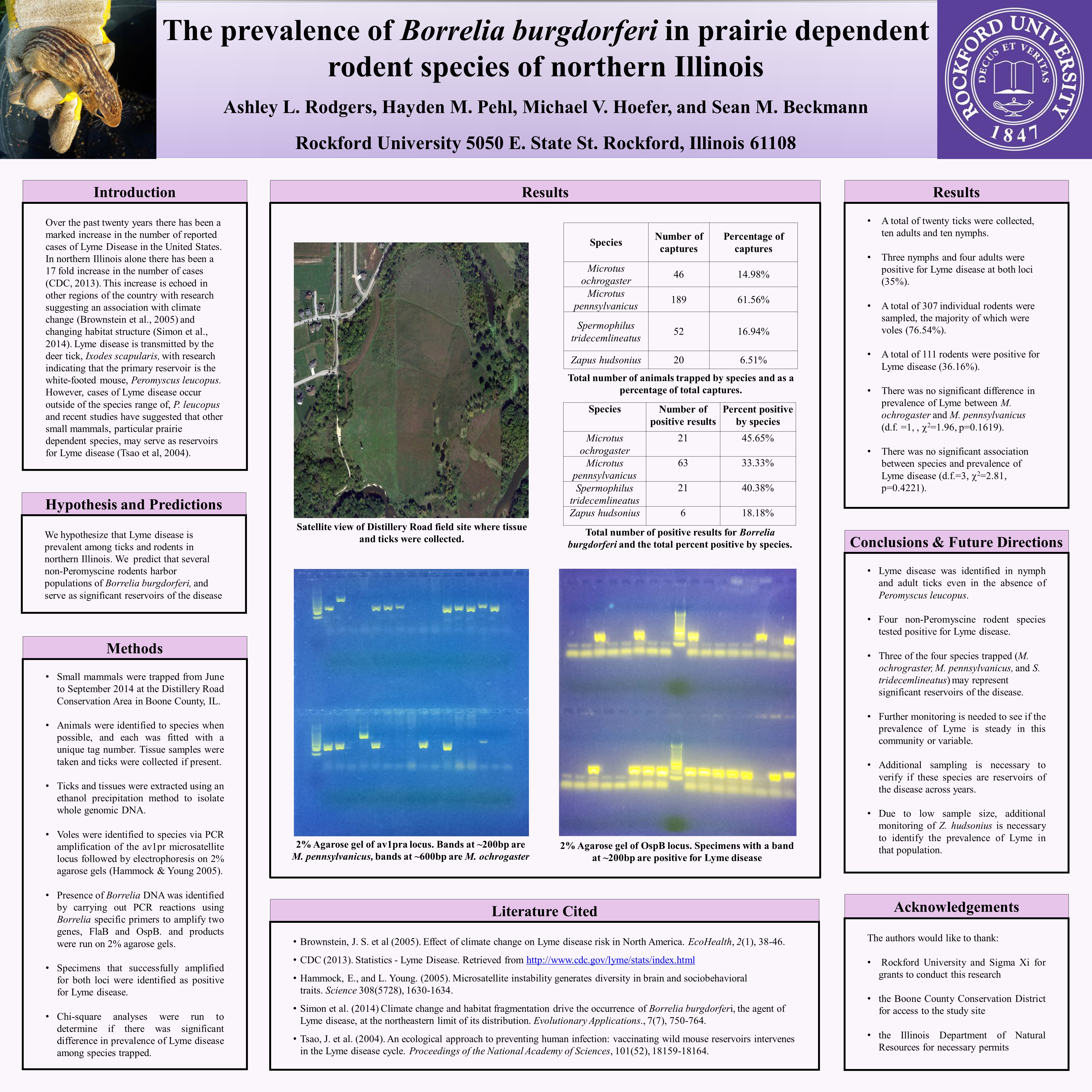About This Project
Lyme disease is the most commonly reported vector borne disease in the United States with over 300,000 human cases reported annually. While the white footed mouse, Peromyscus leucopus, is the most common reservoir of the disease, Lyme is present outside of the range of this species and in habitats it does not use. The goal of this study is to identify what species serve as reservoirs of Lyme disease in restored prairie ecosystems and how common the disease is in these ecosystems.
Ask the Scientists
Join The DiscussionWhat is the context of this research?
Lyme disease is a debilitating bacterial infection found throughout the US, including all 50 states, as well as Europe, and Asia. Borrelia burgdorferi, is the causative agent of Lyme disease. The disease is spread by ticks that harbor the bacteria in their gut and transmit it to other hosts when they feed, including humans. Ticks acquire the bacteria when they feed on the blood of small mammals as larvae or nymphs.
Small mammals that harbor the disease are called reservoirs. The primary reservoir of the disease is the white-footed mouse, Peromyscus leucopus. However, the disease occurs in areas outside of the range of P. leucopus as well as in habitats that are not utilized by these mice. We aim to identify other reservoirs of the disease in prairie ecosystems.
What is the significance of this project?
Lyme Disease is an increasing significant zoonotic pathogen, with a major increase in diagnosed cases in the Midwest since 2000 (CDC).
Studies have focused on ways to mitigate the disease in natural rodent populations, but mostly focused on P. leucopus. However, Lyme is present even in the absence of P. leucopus.
Other studies have shown that other rodents carry the disease and may serve as reservoirs. By identifying the presence and prevalence of Borrelia among prairie-dependent rodents it will be possible to develop conservation & restoration plans that may control the disease while also restoring natural habitats.
These efforts not only improve the habitat and ecology of these areas, but also to foster stewardship by humans that utilize these restored natural areas.
What are the goals of the project?
The overarching goal of this project is to identify the dynamics of Lyme disease in prairie ecosystems. We will use molecular methods to identify which small mammal species are infected by Borrelia burgdorferi, the bacterial species that causes the disease.
We will then identify how prevalent the disease is in each rodent species on the prairie in order to identify the major reservoirs of the disease in these ecosystems.We will also determine how prevalent the disease is among ticks on the prairie to verify that transmission is occurring.
Finally, we plan to sequence the DNA of Lyme positive samples in order to identify the specific strains of Lyme disease that are most common in this area.
Throughout the project undergraduates will engage in the lab and field, gaining valuable skills.
Budget
We are an undergraduate science program at a small liberal arts university. This research actively engages college students in the laboratory and field. It also enables them to present our findings at regional and national conferences.
The funds raised through this campaign will allow us to continue to monitor Lyme disease in the rodent tissue samples and ticks we collect from our field site at the Distillery Road Conservation Area in Boone County, IL. They will be used primarily to purchase the chemicals necessary to identify if an animal has Lyme disease and to have the positive samples sequenced to identify the strains and species of bacteria present.
As we move forward I will post updates on the preliminary data we already have and the results we will continue to acquire in the coming year.
The plan is also to do this over several years to see how the prevalence of Lyme changes in this ecosystem over time.
Endorsed by
Meet the Team
Sean Beckmann
Like most students interested in the sciences I started out on a pre-health track. It wasn't until my undergraduate mentor introduced me to research that I discovered there were other options. I caught the research bug and changed my career.
I joined the faculty of Rockford University in 2011 as Assistant Professor of Biology. Prior to that I earned my Bachelor's Degree in Biology from Stetson University (DeLand, FL). In the following years I received training in a number of areas of biological research, as well as veterinary medicine, before beginning graduate school. I completed my Ph.D. in biology at the University of Miami with focuses in molecular ecology, evolutionary biology, and population genetics.
My primary responsibilities are teaching majors level biology course. I teach a number of courses ranging from General Biology to Cell Physiology, Invertebrate Zoology, Mammalogy, and Field Ecology. I also really enjoy teaching courses in Anatomy and Physiology.
The great part about my job is that I also get to conduct research with undergraduate students on a regular basis. I currently have 10 undergraduate research students working on a number of projects, and many of them have presented at conference in the last two years. It's my true passion to engage students in both the lab and the field and show them what career options they have while teaching them a valuable set of skills that they can use in any scientific career.
My primary research interests are in population and community ecology of small mammals, as well as disease ecology. My background is in population genetics and phylogeography. As a result I always try to bridge the gap between the lab and field, spending some time in both. That also allows me to use molecular approaches to answer a number of different ecological questions.
Additional Information
This is a poster of some of our preliminary results from last year. These were presented at a national conference last June by a group of three undergraduates working in my lab.

Project Backers
- 15Backers
- 10%Funded
- $420Total Donations
- $28.00Average Donation


